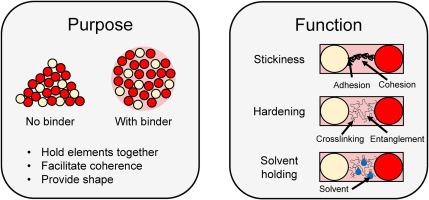Food Hydrocolloids ( IF 11.0 ) Pub Date : 2023-07-12 , DOI: 10.1016/j.foodhyd.2023.109077
Eva Herz , Pascal Moll , Christophe Schmitt , J. Weiss

|
Background
Binding agents have emerged as an important and required class of ingredients to manufacture a wide range of new food products, especially semi-solid or solid vegan meat and dairy analogues.
Scope and approach
In this review, we give a definition for this class of ingredients, look at what constitutes required functionalities for binders, and highlight what molecular mechanisms are involved to give rise to these functionalities. Furthermore, an overview on food binders, such as animal-derived/plant-based proteins (myofibrillar proteins, egg white protein, gluten etc.) and carbohydrate-based (methylcellulose, carrageenans etc.) is given and their functions are explained.
Key findings and conclusion
Three functions have been identified as critically important: stickiness, hardening and water binding. Analytical methods to determine these characteristics are presented and it is recommended to study those simultaneously in model systems, where methylcellulose or gluten might serve as benchmark.
中文翻译:

食品中的粘合剂:定义、功能和表征
背景
粘合剂已成为制造各种新食品,特别是半固体或固体纯素肉类和奶制品的重要且必需的成分。
范围和方法
在这篇综述中,我们给出了此类成分的定义,研究了粘合剂所需功能的构成,并强调了产生这些功能所涉及的分子机制。此外,还概述了食品粘合剂,例如动物源/植物蛋白(肌原纤维蛋白、蛋清蛋白、麸质等)和碳水化合物(甲基纤维素、角叉菜胶等),并解释了它们的功能。
主要发现和结论
三个功能被认为是至关重要的:粘性、硬化和水结合。提出了确定这些特征的分析方法,并建议在模型系统中同时研究这些特征,其中甲基纤维素或麸质可以作为基准。































 京公网安备 11010802027423号
京公网安备 11010802027423号